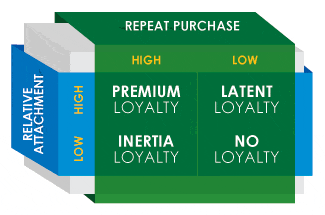Customers will exhibit various versions of customer loyalty depending on their buying habits. Whether we are playing the role of retailer or the role of the consumer, we understand this foundational principle. It is, in many ways, the basis for the dealer’s desire to understand our clientele. Understanding individuals’ buying habits helps us become better marketers, better salespeople, and better retailers overall.
Our buying habits as consumers are determined first by our circumstances (e.g. geographic location, family dynamic, financial status, etc.), and second, by our relationship with a retailer and its products. This professional (and on some levels, personal) relationship is influenced by the need for goods or services. Additionally, the opinions of our friends and family, and by our past experiences with products and retailers holds a similar weight.
Here are the various types of customer loyalty, with both high and low repeat purchase frequencies.
No Loyalty
For varying reasons, some customers do not develop loyalty to certain products or services. For example, someone may go anywhere to get a haircut, so long as it costs them $20 or less, and they don’t have to wait. They rarely go to the same place more than one time. To them, a haircut is a haircut, regardless of where they receive it. This customer’s low attachment towards these services, combined with low repeat patronage, signifies an absence of loyalty. Generally speaking, businesses should avoid targeting “no loyalty” buyers. They add little to the financial strength of the business. While it is important to deliver exceptional service to each customer, expending more energy on those whose loyalty can be developed is the best way to generate revenue and repeat customers.
Inertia Loyalty
A low level of attachment, coupled with high repeat purchase, produces inertia loyalty. This customer purchases out of habit. The retailer they purchase from will frequently carry what they need, and buying from them becomes convenient for the customer. In other words, non attitudinal, situational factors are the primary reason for a repeat purchase. This buyer feels some degree of satisfaction with the company, or at least no real dissatisfaction. This type of loyalty consists of purchases, such as gas at the closest station and groceries from the neighborhood store. However, this buyer is interested in a product that can demonstrate a tangible benefit, making it possible to turn inertia loyalty into premium loyalty. By actively courting the customer and increasing the positive differences between your product or service versus others’.
Latent Loyalty
A high relative attitude combined with low repeat purchase signifies latent loyalty. A consumer may never step foot in a business for reasons, such as long wait times, high volume of people, the absence of a preferred product, etc. If a customer has latent loyalty, situational effects rather than attitudinal influences determine repeat purchase. By understanding situational factors that contribute to latent loyalty, a business can devise a strategy to gain that customer’s loyalty for future repeat purchases.
Premium Loyalty
Premium loyalty, the most impactful of the four, prevails when a high level of attachment and repeat patronage intertwine. This is the preferred type of loyalty for all customers of any business. People of premium loyalty are proud of discovering and using the product, and take pleasure in sharing their knowledge with peers and family. For example, Swiss Army knife enthusiasts are consistently telling others how valuable the knife is, how useful it is, and how often they have used it in a day, a week, or a month. Customers like these become vocal advocates for the product or service. This is a demonstration of premium loyalty.
Questions you may consider asking yourself, as well as your business partners and employees are:
Does your business have a variety of loyalty customers, such as the ones previously mentioned?
How can you promote better customer attachment and improved visit and purchase frequency in all versions of loyalty customers?


